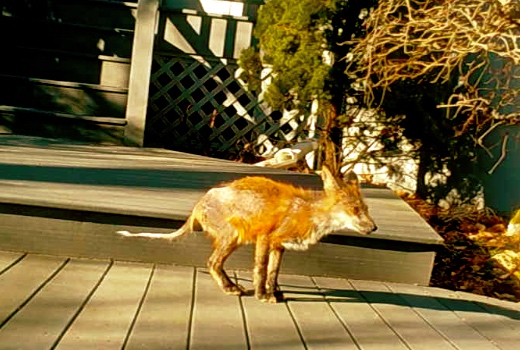
Foxes will often come in close to humans to raise their young , choosing the lesser of two perceived evils- human danger or coyote danger. Because they compete for the same food source, a coyote may kill young foxes to make sure there is plenty of food for her own pups. Foxes will often choose to have their pups close to humans, where the coyotes are less likely to find them when they are very young. As the pups get older, usually around June or July, they are more able escape a coyote on their own, and the coyotes are too busy raising their own families to bother much with foxes anymore. At this time, the young foxes will leave the safety of the yard for more wild places. soon after that, usually starting in September, the foxes will disperse, often travelling more than 100 miles to find a new territory.
Watching a fox family grow up is a very safe, entertaining and educational way to enjoy Spring and part of Summer. Before you decide to evict the family, consider allowing them to rent your space, and in turn, you and possibly your neighbors will have a rodent free yard and what will most likely be your best gardens ever. In addition, you may also be able to take some very beautiful photos and cute videos!
A healthy fox family won’t hurt children or pets. The most a protective action a parent fox might take is chase a domestic cat that gets too close to her babies back to your back deck or up a tree. Foxes don’t want to kill or eat your dogs, cats or kids. The average fox rarely tops 11 pounds. It is very important to know that a mother fox will hunt all times of the day and night. Often the male will leave early on, leaving the female to work very hard, hunting 24/7 to bring back food for her growing pups.Unfortunately, humans who don’t know this will be alarmed to see a fox running through their yard during the day and sometimes extreme action such as shooting the mother fox will be taken, creating orphans. Because momma foxes are often crossing roads more often, sometimes she will be hit by a car. If this happens, a trail cam to make sure that the pups are indeed orphaned will help to determine what action to take if any. Often orphaned pups are old enough to survive and leave on their own. Contacting a knowledgeable Wildlife Rehabilitator at this time can help determine the best course of action.
If you choose to convince the foxes to move, the earlier you do it, the better. The older the family gets, the less the female is sensitive to interference. Because a mother fox is concerned about coyotes, using coyote urine in the area will make her think a coyote is around. It is very likely she will move her pups within days to a new secret location far from the “marked” area. Sprinkle the coyote urine around the den area. Again, the younger the pups are, the more effective this is.
Putting a foreign object such as a chair near the den may also help convince mom that her den has been discovered. However, keep in mind we don’t want to frighten her too much so that she isn’t comfortable retrieving her pups and we want to make sure she has a clear and safe entrance and exit to get them out one by one. Often simply increasing your activity in the area works. Don’t be afraid to use your deck, mow your lawn, do your gardening. Mother foxes aren’t aggressive protectors like grizzly bears. The most they will do is stand at a distance, watching you and bark a warning for her pups to take cover because danger is near. This is not a warning to you, it is a warning to her pups- YOU are the danger.
Balloons are very scary to foxes, especially when they move in the breeze. Punch balloons, sold as children’s toys are inexpensive and hardy and when a small handful of beads or pebbles are placed inside them before inflated, they make scary noises too! When placed appropriately about 2 feet off the ground, they will discourage a fox from coming into or traveling through your yard.
Hiring a Nuisance Control company to trap and remove the foxes rarely works out well for the foxes or your pocketbook. Only the very young will be captured, and usually only a few. The parents will not be easy to catch, and relocation is not going to work. Most likely all that will happen is the fox family will be fragmented or destroyed and you will spend a lot of money. “Relocation” of a fox family by a trapper is not realistic, so please don’t fall for that. You will be wasting your money. As suggested earlier in this piece, to convince the female to relocate her own family using one or all of these methods mentioned is the most effective and humane way.
Most likely, the family will be gone by late June or July. Foxes only use a den to raise their families, and the rest of the year, they are nomads, napping under trees and wherever they find a quiet place. If you don’t want them back again next year, mid-July is the time to do repairs and permanent exclusion from the area with strong fencing, concrete block, or rocks. This will prevent not only foxes, but skunks, raccoons and woodchucks from using the space to raise their young.




















